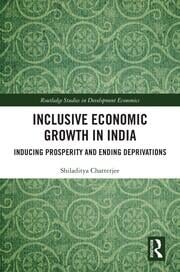
Author(s): Shiladitya Chatterjee
Publishers: Routledge, London
Pages: 218
First Edition 2024
ISBN: 9781003460626
Inclusive Economic Growth in India
About this book |
| Inclusive Economic Growth in India Chatterj~e dis~usses India’s economic strengths and weaknesses and its progress towards mclus1ve growth by providing an overview of the Indian economy., its future challenges and current policy strategies.
Chatterjee’s overview of the economy touches on its historical, geographical and socio-political context. Considering the factors that contribute to its current gro,vth such as India’s low dependency ratio, vast internal market and growing private sector and entrepreneurial class, he argues that inclusive growth rests amongst others on agricultural transformation and targeted policies that address the needs of medium, small and microenterprises (MSMEs) which dominate industry and constitute the majority of the informal and services economy; and also interventions directed at social groups and geographical regions falling behind. Benchmarking India’s progress on achieving the Sustainable Development Goals (SDGs), this book closes by advancing policy options to address various inequities and deprivations including social inequalities, in particular the issues of ethnic division, gender and caste, going beyond the blunt instrument of affirmative action. Having served at the state and central levels of Indian government and the Asian Development Bank, Chatterjee presents the pressing issues of inclusive growth in India in an accessible volume, one of interest to development economists, researchers in development studies and inclusive growth as ,veil as policy makers. |
| Shiladitya Chatterjee is visiting senior fellow at the Institute for Studies in Industrial Development, New Delhi. He 1s also the president of Global Forum for Sustainable Rural Development. |
Table of contents (10 chapters) (Preview) |
|

